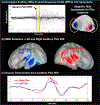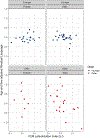Maturation of auditory cortex neural responses during infancy and toddlerhood
- PMID: 37178820
- PMCID: PMC11463054
- DOI: 10.1016/j.neuroimage.2023.120163
Maturation of auditory cortex neural responses during infancy and toddlerhood
Abstract
The infant auditory system rapidly matures across the first years of life, with a primary goal of obtaining ever-more-accurate real-time representations of the external world. Our understanding of how left and right auditory cortex neural processes develop during infancy, however, is meager, with few studies having the statistical power to detect potential hemisphere and sex differences in primary/secondary auditory cortex maturation. Using infant magnetoencephalography (MEG) and a cross-sectional study design, left and right auditory cortex P2m responses to pure tones were examined in 114 typically developing infants and toddlers (66 males, 2 to 24 months). Non-linear maturation of P2m latency was observed, with P2m latencies decreasing rapidly as a function of age during the first year of life, followed by slower changes between 12 and 24 months. Whereas in younger infants auditory tones were encoded more slowly in the left than right hemisphere, similar left and right P2m latencies were observed by ∼21 months of age due to faster maturation rate in the left than right hemisphere. No sex differences in the maturation of the P2m responses were observed. Finally, an earlier left than right hemisphere P2m latency predicted better language performance in older infants (12 to 24 months). Findings indicate the need to consider hemisphere when examining the maturation of auditory cortex neural activity in infants and toddlers and show that the pattern of left-right hemisphere P2m maturation is associated with language performance.
Keywords: Auditory; Hemisphere lateralization; Infant; Language; MEG; P2m.
Copyright © 2023. Published by Elsevier Inc.
Conflict of interest statement
Declaration of Competing Interest None.
Figures





References
-
- ALBOUY P, BENJAMIN L, MORILLON B, ZATORRE RJ, 2020. Distinct sensitivity to spectrotemporal modulation supports brain asymmetry for speech and melody. Science 367, 1043–1047. - PubMed
-
- BARNET AB, 1975. Auditory evoked potentials during sleep in normal children from ten days to three years of age. Electroencephalogr. Clin. Neurophysiol 39 (1), 29–41. - PubMed
-
- BAYLEY N, 2006. Bayley Scales of Infant and Toddler Development-Third Edition. Harcourt Assessment, San Antonio, TX.
Publication types
MeSH terms
Grants and funding
LinkOut - more resources
Full Text Sources

